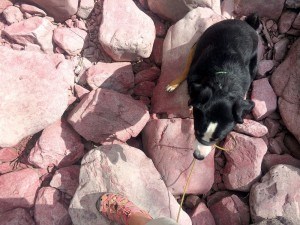
One of the wonderful things about living in the community for whom you write, is when every once in a while you get a phone call like this: “I have a mystery for you. Can I come over?”
Two weeks ago, these were the words of local graphic designer and landscaper Su Young-Leslie, who, while exploring the dry riverbed of the upper Maligne River (the Excalibur outflow on the north end of Medicine Lake), came across some unusually coloured rocks.
Soon, Young-Leslie was at my house with photos and powdery scrapings of this mysterious phenomenon. She obtained the samples from a small rocky depression, where she suspects rain, flood or melt water collected and remained until it evaporated over the summer. It caught her eye, she said, “because the rocks, large and small, were all reddish in colour.”
After first consulting with geologist and naturalist Ben Gadd, then blowing the dust off my microscope and tossing the specimen on a slide, the culprit revealed itself. Stark and magnified against the white light of the scope were thousands of characteristic round spores left behind by the cold-loving, green algae that causes watermelon snow.
Known to scientists as Chlamydomonas nivalis, this algae is unlike its cousins that are commonly found in freshwater habitats. Instead, it makes a living on the snowfields and glaciers in the mountains. It can be observed during the late spring and summer snowmelt, when affected snow patches take on a pink or reddish hue resembling that of watermelon, but not as tasty (don’t eat it).
The algae gets its pink and red colouring from carotenoid pigment that protects chloroplasts—the photosynthesizing powerhouses of plant cells—from being degraded by sunlight and other ultraviolet radiation within the algae cells.
As the algae multiply, they develop into algal blooms on the snow that can extend to a depth of up to 10 cm, and can become almost blood red at high densities. As the snow melts, the algal pigments concentrate, in some cases causing a phenomenon known as “sun cups”—shallow depressions in the snow that accelerate snow melt as the pigment continues to concentrate.
Eventually, melting watermelon snow collects as somewhat unsettling dark pink or red pools in rock pockets and other impervious depressions.
I once hiked up the back of Mt. Fitzwilliam, only to discover every nook and cranny filled with this blood red liquid, as if a giant had stumbled, bleeding, up the valley to the mountain top.
As was likely in the case in Young-Leslie’s find, eventually the water evaporates, leaving the powdery carotenoid pigments to settle on the substrate beneath the snow. In the case of the upper Maligne River, the light grey and white river rocks display the colour prominently, aided by the fact there wasn’t much rain this past summer to wash it away.
The dried spores will remain dormant under the snow pack in the winter months until in the spring some of the cells activate and migrate to the snow’s surface to begin the cycle again. Exactly how this happens is still being investigated.
In the meantime, I’ll keep an eye on Young-Leslie, who says, “Anything mysterious or historical always has my attention.”
I’m glad it does.
Niki Wilson
Special to the Fitzhugh
